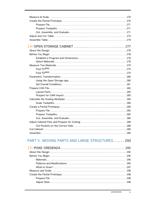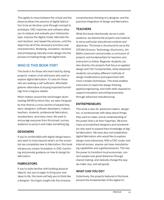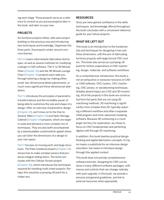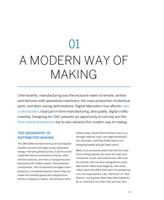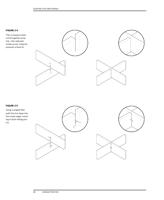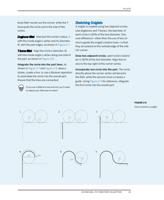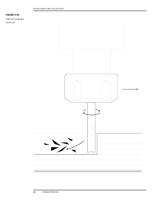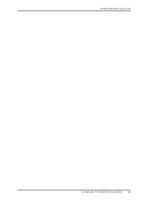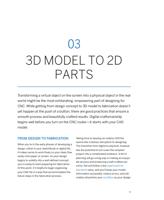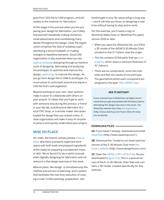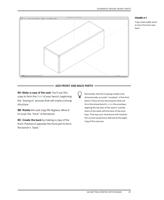
cator could produce with readily available sheet
materials and intuitively assemble with nothing
more than off-the-shelf hardware.
AtFAB’s underlying ideas are also rooted in our
deep aspiration to connect and share through
design and making. Ever since inviting a few
dozen friends to download our earliest furniture
files, we’ve been delighted to connect with an
ever-growing, global network of designers,
makers, and fabricators. As so many have
downloaded, customized, and locally fabricated
AtFAB in makerspaces, fab labs, classrooms,
and garages around the world, they have
demonstrated a powerful manufacturing
model.
For us, this book is an opportunity to expand
the circle further, by sharing the knowledge
that we developed in designing and making
AtFAB. We hope to expand this creative, indus-
trious community into a potent force that has
the potential to reshape an industry.
For all makers, we believe AtFAB demonstrates
an approach to design that anyone can adapt
to their own projects. This book will walk you
through the making of eight AtFAB furniture
pieces, showing how design unlocks digital fab-
rication’s full potential. As you make each
project, you’ll discover how AtFAB designs are
source code for infinite furniture possibilities.
You’ll find opportunities for customizing, hack-
ing, and even recombining elements into new
designs to make and to share.
What Is CNC?
At its most basic, a computer-numerically con-
trolled (CNC) machine moves a cutting, etch-
ing, or deposition tool on the end of its
computer-controlled arm. The computer reads
a digital file containing 2D or 3D coordinates,
and tells the machine where to move the tool to
perform subtractive functions like cutting,
carving, or etching, or additive ones like 3D
printing.
The principles are essentially the same on a
CNC router that cuts and etches sheets of ply-
wood, or on a sophisticated, infinite-axis CNC
robotic arm that cuts and fuses complex aero-
space parts. In both cases, the computer is fol-
lowing the coordinates and driving the end of a
tool in space to manipulate a physical material.
A MANUAL FOR MODERN DESIGN
When Gary Rohrbacher began his first job in a small
architecture practice, the office had a set of 19th-
century leather-bound woodworking handbooks.
The architects in the office adapted and translated
the construction details in the books to whatever
projects were being designed at the time. These
details became the consistent thread that linked all
the projects of the firm together.
Our goal is for this book to serve a similar function
as those antique woodworking manuals. We wrote it
as an essential resource for anyone designing for
CNC. First by illustrating simple steps toward suc-
cessful outcomes in your CNC projects, and then by
providing basic principles for you to adapt and
translate into your own designs.
What Is Digital Fabrication?
Digital fabrication is the act of designing on a
computer with the intent of fabricating that
design on a specific computer-controlled
machine. While digital fabrication is the process
of joining digital design with computer-
controlled tools, the practice of digital fabrica-
tion feels more like an iterative dance between
software and hardware with design as the chor-
eographer. The process typically involves creat-
ing a digitally designed model, simulating its
fabrication in software, and then physically fab-
ricating that model with a CNC machine.
xviii
DESIGN FOR CNC













